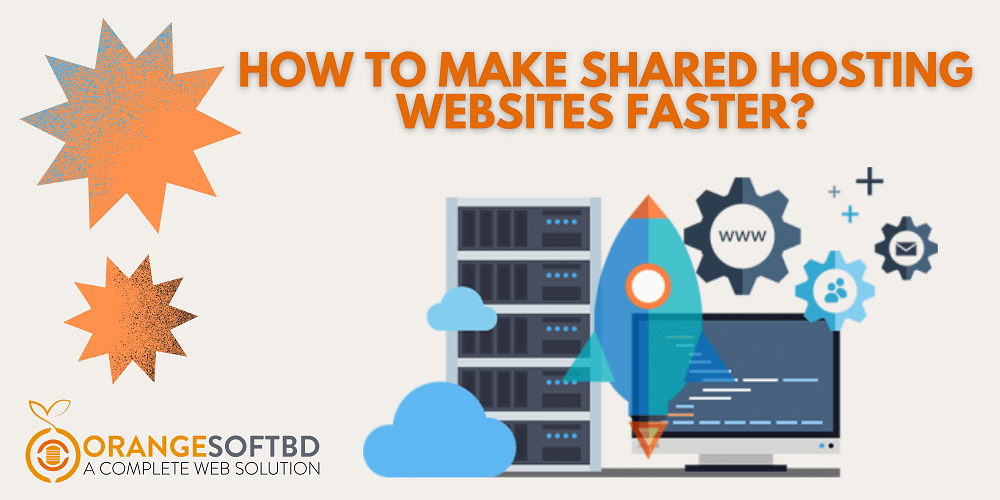
How to Make Shared Hosting Websites Faster
Shared hosting is ideal for small websites with average traffic, but it will never provide the same level of speed and performance as a VPS, cloud, or dedicated server. That doesn’t imply there’s nothing you can do to improve the loading and response times of a shared hosting website. If you want to improve the speed of your website, this is how you may do it.
Why is the speed of your website important?
When ranking websites in search results, Google’s core algorithm now considers various speed-related parameters. Without getting into the nitty-gritty, these are the times it takes for your page to load in a user’s browser and for the website to respond to interactions, such as when a user submits information or clicks on a link. Poor performance in either of these areas can have an influence on your website’s ranking and, as a result, the number of visits it receives.
Modern users expect websites to appear and reply almost instantly, thanks to advancements in website creation, hosting, and linked gadgets. As a result, visitors’ tolerance for slow websites has decreased, and the majority would exit a page after a few seconds.
Why is website speed important in shared hosting?
The main distinction between shared and other types of hosting is that the server’s resources are shared by all of the websites it hosts, limiting the amount of storage, RAM, and CPU you have. While these are usually adequate for tiny sites, if your site receives a lot of traffic, speed and performance may suffer. If other sites on the server are also busy at the same moment, this might worsen the situation and affect everyone else.
How can a shared hosted website be made faster?
Here are some things you can do to speed up your shared hosting website and reduce the impact of restricted resources and noisy neighbors.
1. Enable compression with gzip.
How much data your site delivers and receives has an impact on its speed. Gzip compression reduces the size of the data by up to 90%, reducing the time it takes for the site to load and reply. Gzip compression can be enabled in your control panel or by modifying the. htaccess file.
2. Make use of caching
Static and dynamic parts make up websites. The static ones are those that never change, whereas the dynamic ones (for example, displaying the time and date) do. Caching is the process of temporarily storing copies of static files off your server so that they can be loaded faster. The most typical location for them is on the user’s device, generally in the cache of the browser. Some control panels allow you to turn on website caching with a single click. If this is not possible, certain plugins will suffice.
3. Remove any plugins that aren’t necessary.
Plugins enhance the quantity of data sent between your website and the browser of the user. If you have a large number of them, the combined impact can slow loading and response times. You should keep plugins if they are necessary. If they aren’t, though, deleting them may improve performance. You should also remove any plugins that have been deactivated and are no longer in use. You might also be able to find other plugins that have a lower impact on your speed.
4. Choose a lightweight theme to use.
Developers are designing increasingly complicated themes as websites get more advanced. While these might give you a lot more control over the design and features of your site, they are data-heavy and take a long time to load. A lighter theme may assist boost your speed if your current theme has more features and choices than you require.
5. Make use of a content distribution network (CDN)
The distance your data must travel over the internet to reach the user’s browser might also affect site speed. A content delivery network (CDN) is a type of cache that stores static pieces of your website on servers located all over the world. CDNs are paid services that can improve the performance of websites with international clients all over the world.
6. Make image enhancements
Images are some of your website’s largest files, and current sites, particularly online businesses, have a lot of them. This implies they’ll have an impact on how quickly the site loads. By optimizing your photos, you can lessen the impact. Make sure your photos are.jpg or.png files with a resolution of no more than 72 dpi. Also, make sure you upload photos that are the correct size for your theme to avoid resized copies being generated automatically. You may use plugins to optimize your images for you.
7. Make use of lazy loading.
Another technique to optimize images is to use lazy loading, which staggers image loading such that the ones that should be seen on the screen are loaded first. Those below the fold are held in reserve until all of the other content has loaded and the user has scrolled down. If your theme doesn’t have lazy loading built-in, you can utilize a plugin to do so.
8. Make your database more efficient.
The majority of websites rely on databases to store their content. Your database, like your PC, can become clogged with unwanted content like outdated post drafts and spam comments. A database optimizer plugin can improve the performance of your database. It’s similar to defragging your computer’s hard drive.
9. Do you need a real speed boost? Upgrade to a better hosting package.
If you truly want to speed up your website, upgrading to a more powerful hosting service is the best option. A VPS, or virtual private server, is an apparent step up from shared hosting. It is compatible with all types of websites, including WordPress; you can quickly transfer your website to it while still using control panels such as cPanel. The best part is that it will only cost you a few additional pounds per month while providing you with all of the performance and speed of a tiny dedicated server.
Conclusion
For a better rating and to keep users on your website, site speed is critical. If you have a shared hosting package and your site isn’t loading as quickly as it should be, the information above should be able to help. Visit our VPS Hosting page if you’re thinking about upgrading to a VPS.













